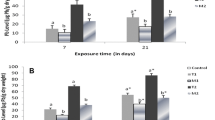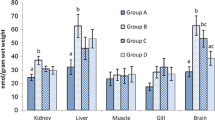Abstract
In the present research, the effects of sublethal lead (Pb) concentrations on total antioxidant status (TAS), total oxidant status (TOS), oxidative stress index (OSI) levels, enzyme activities (aspartate transaminase, AST; alanine transaminase, ALT; lactate dehydrogenase, LDH), ion levels (magnesium, Mg; sodium, Na; potassium, K; chlorine, Cl; calcium, Ca), and some metabolite levels (cholesterol, triglyceride, HDL, LDL, albumin, total protein) in the blood serum of Oreochromis niloticus and the protective function of nitrilotriacetic acid (NTA) due to its chelating characteristic were investigated. O. niloticus, which has an important position in the food chain and is often preferred in toxicological studies, was exposed to 0.1 ppm Pb, 0.1 ppm Pb + 0.3 ppm NTA, 1 ppm Pb, and 1 ppm Pb + 3 ppm NTA concentrations for 7 and 21 days. At the end of the duration, serum TAS and TOS levels were measured spectrophotometrically with Rel Assay Diagnostics; other enzyme activities, ion levels, and metabolite parameters were done by an autoanalyzer using commercial kits. Depending on the exposure periods and concentrations, the changes in the parameters were determined. It is determined that, under the influence of high ambient concentration of lead, TOS, OSI, AST, ALT, LDH, LDL, triglyceride, and Mg levels increased, while TAS, albumin, and K levels decreased after 21 days. These increases/decreases in all serum biochemical parameters were generally higher in fish treated with Pb alone compared to fish treated with a mixture of Pb + NTA. This study shows that these changes in serum parameters could be used as an indicator to assess on metal toxicity.
Similar content being viewed by others
References
Gülhan MF, Akgül H, Dastan T, Durna Dastan S, Selamoglu Talas Z (2014) Effects of different concentrations of pollen extract on brain tissues of Oncorhynchus mykiss. J Coast Life Med 2(3):169–174. https://doi.org/10.12980/JCLM.2.2014JCLM-2013-0001
Firidin G (2019) Effects of lead and its selenium mixtures on biochemical parameters of Oreochromis niloticus. Fresenius Environ Bull 28(1):383–390
Hu S, Su Z, Jiang J, Huang W, Liang X, Hu J, Chen M, Cai W, Wang J, Zhang X (2016) Lead, cadmium pollution of seafood and human health risk assessment in the coastline of the southern China. Stoch Env Res Risk A 30:1379–1386. https://doi.org/10.1007/s00477-015-1139-9
Chen M, Ding S, Lin J, Fu Z, Tang W, Fan X, Gong M, Wang Y (2019) Seasonal changes of lead mobility in sediments in algae and macrophyte dominated zones of the lake. Sci Total Environ 660:484–492. https://doi.org/10.1016/j.scitotenv.2019.01.010
Çoğun HY, Şahin M (2012) The effect of zeolite on reduction of lead toxicity in Nile tilapia (Oreochromis niloticus Linnaeus, 1758). Kafkas Univ Vet Fak Derg 18(1):135–140. https://doi.org/10.9775/kvfd.2011.5170
James R, Sampath K, Selvamani P (1998) Effect of EDTA on reduction of copper toxicity in Oreochromis mossambicus. Bull Environ Contam Toxicol 60:487–493. https://doi.org/10.1007/s001289900651
Zhang Y, Klamerth N, Chelme-Ayala P, Gamal El-Din M (2017) Comparison of classical Fenton, nitrilotriacetic acid (NTA)-Fenton, UV-Fenton, UV photolysis of Fe-NTA, UV-NTA-Fenton, and UV-H2O2 for the degradation of cyclohexanoic acid. Chemosphere 175:178–185. https://doi.org/10.1016/j.chemosphere.2017.02.058
Aslan R, Kutlu R, Civi S, Tasyurek E (2014) The correlation of the total antioxidant status (TAS), total oxidant status (TOS) and paraoxonase activity (PON1) with smoking. Clinic Biochem 47:393–397. https://doi.org/10.1016/j.clinbiochem.2013.10.002
Kovacik A, Tvrda E, Miskeje M, Arvay J, Tomka M, Zbynovska K, Andreji J, Hleba L, Kovacikova E, Fik M, Cupka P, Nahacky J, Massanyi P (2019) Trace metals in the freshwater fish Cyprinus carpio: effect to serum biochemistry and oxidative status markers. Biol Trace Elem Res 188:494–507. https://doi.org/10.1007/s12011-018-1415-x
Klisic A, Kavaric N, Vujcic S, Spasojevic-Kalimanovska V, Kotur-Stevuljevic J, Ninic A (2020) Total oxidant status and oxidative stress index as indicators of increased Reynolds risk score in postmenopausal women. Eur Rev Med Pharmacol Sci 24:10126–10133
Firat Ö, Çoğun HY, Aytekin T, Gök G, Firat Ö, Kargin F, Kötemen Y (2011) A comparative study on the effects of a pesticide (cypermethrin) and two metals (copper, lead) to serum biochemistry of Nile tilapia, Oreochromis niloticus. Fish Physiol Biochem 37:657–666. https://doi.org/10.1007/s10695-011-9466-3
Firat Ö, Şahin-Inandi A (2016) Biochemical toxicity of mercury and protective effect of zeolite on this toxicity in Oreochromis niloticus. Turk J Aquat Sci 31(2):86–95. https://doi.org/10.18864/TJAS201610
Kumari K, Ranjan N, Sinha RC (2011) Multiple biomarker response in the fish, Labeo rohita due to hexavalent chromium. 2nd International Conference on Biotechnology and Food Science 7: 155–158
Folmar LC (1993) Effects of chemical contaminants on blood chemistry of teleost fish: a bibliography and synopsis of selected effects. Environ Toxicol Chem 12:337–375. https://doi.org/10.1002/etc.5620120216
Pelgrom SMGS, Lock RAC, Balm PHM, WendelaarBonga SE (1995) Effects of combined waterbone Cd and Cu exposures on ionic and plasma cortisol in Tilapia Oreochromis mossambicus. Comp Biochem Physiol 111C:227–235. https://doi.org/10.1016/0742-8413(95)00041-L
Adham KG, Al-Eisa NA, Farhood MH (2011) Impact of heavy metal pollution on the hemogram and serum biochemistry of the Libyan jird, Meriones libycus. Chemosphere 84(2011):1408–1415. https://doi.org/10.1016/j.chemosphere.2011.04.064
Cogun HY, Firat O, Aytekin T, Gök G, Firat O, Kargin F, Kötemen Y (2012) Protective effect of selenium against mercury induced toxicity on hematological and biochemical parameters of Oreochromis niloticus. J Biochem Mol Toxicol 26(3):117–122. https://doi.org/10.1002/jbt.20417
Erel O (2004) A novel automated method to measure total antioxidant response against potent free radical reactions. Clin Biochem 37(2):112–119
Erel O (2005) A new automated colorimetric method for measuring total oxidant status. Clin Biochem 38(12):1103–1111. https://doi.org/10.1016/j.clinbiochem.2005.08.008
Demirpençe Ö, Sevim B, Yildirim M, AyanNurlu N, Mert D, Evliyaoğlu O (2014) Serum paraoxonase, TAS, TOS and ceruloplasmin in brucellosis. Int J Clin Exp Med 7(6):1592–1597
Patrick L (2006) Lead toxicity part II: the role of free radical damage and the use of antioxidants in the pathology and treatment of lead toxicity. Altern Med Rev 11(2):114–127
Yilmaz M, Koç E, Atakişi O, Harmankaya A, Ersan Y, Karaman M, Çitil M (2016) The protective effects of L-carnitine against lead (II) acetate toxicity in Capoeta capoeta (Guldensteadt 1773). Kafkas Univ Vet Fak Derg 22(4):511–518. https://doi.org/10.9775/kvfd.2015.14942
Oğuz EF, Çalci E, Bal CD, Yilmaz OH, Tutkun E, Yilmaz FM (2016) Oxidative stress status in lead exposed workers. Turk J Occup Environ Med Saf 1(4):34–40
Kayar A, Dokuzeylul B, Kandemir FM, Kirbas A, Bayrakal A, Or ME (2015) Total oxidant and antioxidant capacities, nitric oxide and malondialdehyde levels in cats seropositive for the feline coronavirus. Veterinarni Medicina 60(5):274–281. https://doi.org/10.17221/8180-VETMED
Kaya I, Yilmaz M, Koç E, Deveci HA, Ersan Y, Karapehlivan M (2014) Tebukonazol (Fungusit) uygulanan Cyprinus carpio (L. 1758)’da serum total antioksidan, oksidan ve salisilik asit düzeylerinin incelenmesi. J Fish Sci 8(3):214–219. https://doi.org/10.3153/jfscom.201427
Soliman HAM, Hamed M, Lee JS, Sayed AEH (2019) Protective effects of a novel pyrazolecarboxamide derivative against lead nitrate induced oxidative stress and DNA damage in Clarias gariepinus. Environ Pollut 247:678–684. https://doi.org/10.1016/j.envpol.2019.01.074
Karataş S, Erdem C, Cicik B (2005) Effect of cadmium on levels of sera aspartate aminotransferase alanine aminotransferase and glucose Cyprinus carpio (L. 1758). Ekoloji 14(55):18–23
Akbary P, Yarahmadi SS, Jahanbakhshi A (2018) Hematological, hepatic enzymes’ activity and oxidative stress responses of gray mullet (Mugil cephalus) after sub-acute exposure to copper oxide. Environ Sci Pollut Res 25:1800–1808. https://doi.org/10.1007/s11356-017-0582-1
Atli G, YuzbasiogluAriyurek S, Kanak EG, Canli M (2015) Alterations in the serum biomarkers belonging to different metabolic systems of fish (Oreochromis niloticus) after Cd and Pb exposures. Environ Toxicol Pharmacol 40:508–515. https://doi.org/10.1016/j.etap.2015.08.001
Mirghaed AT, Yarahmadi P, Harehdasht MS, Craig PM, Farsani HG, Ghysvandi N, Eagdari S (2018) Hemato-immunological, serum metabolite and enzymatic stress response alterations in exposed rainbow trout (Oncorhynchus mykiss) to nanosilver. Int J Aquat Biol 6(4):221–234
Thomas P (1990) Molecular and biochemical responses of fish to stressors and their potential use in environmental monitoring. Am Fish Soc Symp 8:9–28
Stoskopf MK (1993) Clinical pathology in fish. Medicine Saunders Philadelphia 113–131
Vinodhini R, Narayanan M (2009) The impact of toxic heavy metals on the hematological parameters in common carp (Cyprinus carpio L). Iran J Environ Health Sci Eng 6(1):23–28
Klyszejko B, Lyczywek G (1999) Effect of a sublethal concentration of deltametrin on biochemical parameters of the blood serum of carp (Cyprinus carpio L.). Acta Ichth Piscat 29:109–117
Canli EG, Dogan A, Canli M (2018) Serum biomarker levels alter following nanoparticle (Al2O3, CuO, TiO2) exposures in freshwater fish (Oreochromis niloticus). Environ Toxicol Pharmacol 62:181–187. https://doi.org/10.1016/j.etap.2018.07.009
Öner M, Atlı G, Canlı M (2008) Changes in serum biochemical parameters of freshwater fish Oreochromis niloticus following prolonged metal (Ag, Cd, Cr, Cu, Zn) exposures. Environ Toxicol Chem 27(2)360–366. https://doi.org/10.1897/07-281R.1
Yang JL, Chen HC (2003) Effects of gallium on common carp (Cyprinus carpio): acute test, serum biochemistry, and erythrocyte morphology. Chemosphere 53:877–882. https://doi.org/10.1016/S0045-6535(03)00657
Mutlu E (2016) The effects of lead-induced toxicity on metabolic biomarkers in common carp (Cyprinus carpio). Fresenius Environ Bull 25(5):1419–1427
Abdou HM, Hassan MA (2014) Protective role of omega-3 polyunsaturated fatty acid against lead acetate-induced toxicity in liver and kidney of female rats. BioMed Res Int 435857. https://doi.org/10.1155/2014/435857
Shahat MMA, Fouda MMA, Sultan HAA, Ali IO (2018) Evaluation of the protective roles of synthetic zeolite on some physiological and biochemical parameters after cadmium toxicity of crayfish (Procambarus clarkii). Egypt J Hosp Med 72(11):5517–5526. https://doi.org/10.21608/EJHM.2018.11458
Gopal V, Parvathy S, Balasubramanian P (1996) Effect of heavy metals on the blood protein biochemistry of the fish Cyprinus carpio and its use as a bioindicator of pollution stress. Environ Monit Assess 48:117–124
Hedayati SA, Farsanib HG, Naserabadc SS, Hoseinifara SH, Doand HV (2019) Protective effect of dietary vitamin E on immunological and biochemical induction through silver nanoparticles (AgNPs) inclusion in diet and silver salt (AgNO3) exposure on Zebrafish (Danio rerio). Comp Biochem Physiol C 222:100–107. https://doi.org/10.1016/j.cbpc.2019.04.004
Banaee M, Shahafve S, Vaziriyan M, Taheri S, Haghi BN (2016) Effects of sewage effluent on blood biochemical parameters of common carp (Cyprinus carpio): a case study of Behbahan, Khuzestan Province. J Chem Health Risks 6(3):161–173. https://doi.org/10.22034/JCHR.2016.544144
Mohiseni M, Asayesh SS, Bazarnoie SS, Mohseni F, Moradi N, Matouri M, Mirzaee N (2016) Biochemical alteration induced by cadmium and lead in common carp via an experimental food chain. Iran J Toxicol 10(4):25–32
Latif A, Khalid M, Ali M (2014) Evaluation of toxic stress of copper sulphate and lead nitrate on hematological and serum biochemical characteristics of freshwater cyprinid (Labeo rohita). Int J Curr Eng Technol 4(1):366–372
Suvetha L, Ramesh M, Saravanan M (2010) Influence of cypermethrin toxicity on ionic regulation and gill Na+/K+-ATPase activity of a freshwater teleost fish Cyprinus carpio. Environ Toxicol Pharmacol 29:44–49. https://doi.org/10.1016/j.etap.2009.09.005
Kalay M (2006) The effect of cadmium on the levels of Na+, K+, Ca++ and Mg++ in serum of Tilapia nilotica (Linnaeus, 1758). Ekoloji 15(59):1–7
Giles MA (1984) Electrolyte and water balance in plasma and urine of rainbow trout (Salmo gairdneri) during chronic exposure to cadmium. Can J Fish Aquat Sci 41:1678–1685. https://doi.org/10.1139/f84-206
Acknowledgements
I would like to thank to Prof. Dr. Ferit Kargin, Prof. Dr. Hikmet Y. Çoğun, and Prof. Dr. Özgür Firat. I also would like to thank to Dr. Selçuk Matyar and Ahmet Aytekin for their help.
Funding
This study was supported by Grant FBA-2018–10696 from Cukurova University.
Author information
Authors and Affiliations
Corresponding author
Ethics declarations
Conflict of Interest
The author declares no competing interests.
Additional information
Publisher's Note
Springer Nature remains neutral with regard to jurisdictional claims in published maps and institutional affiliations.
Rights and permissions
About this article
Cite this article
Aytekin, T. Evaluation of the Effects of Nitrilotriacetic Acid as a Chelating Agent on the Biochemical Toxicity of Lead in Oreochromis niloticus. Biol Trace Elem Res 200, 2908–2914 (2022). https://doi.org/10.1007/s12011-021-02973-y
Received:
Accepted:
Published:
Issue Date:
DOI: https://doi.org/10.1007/s12011-021-02973-y




